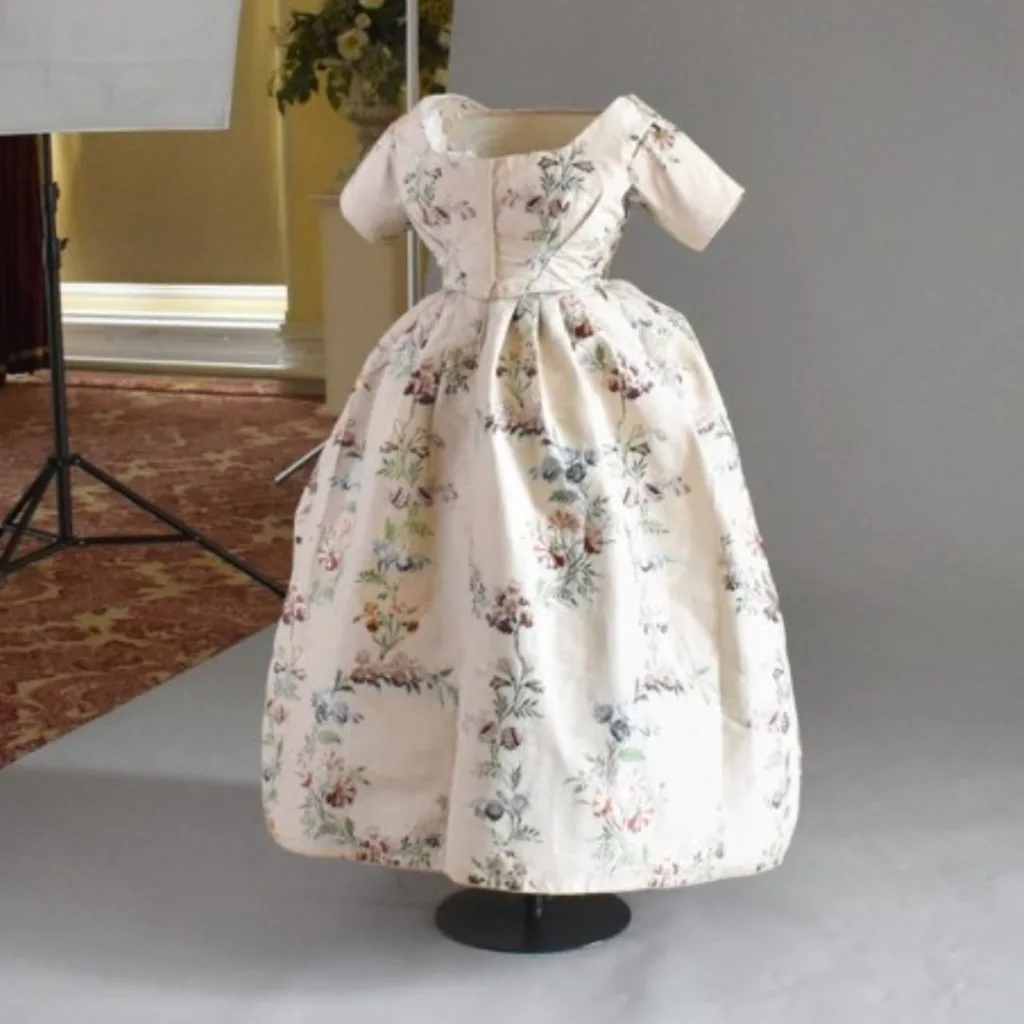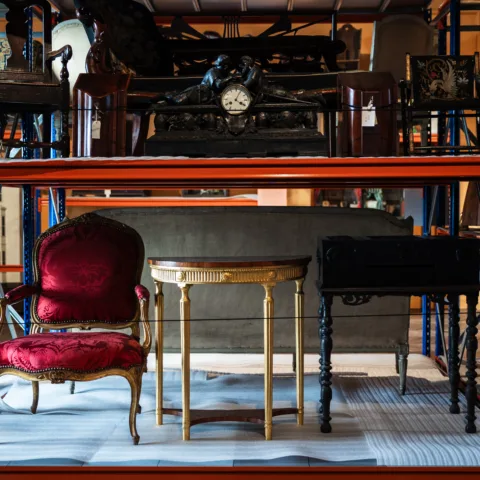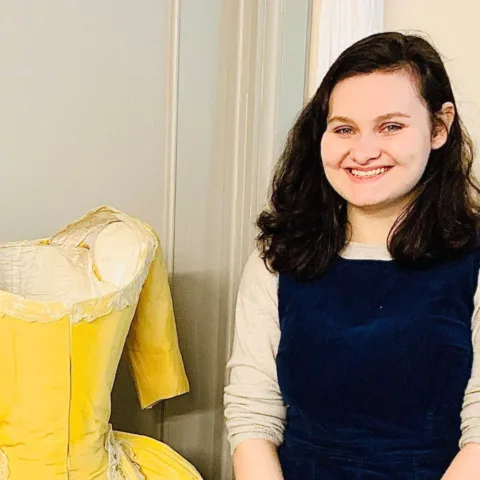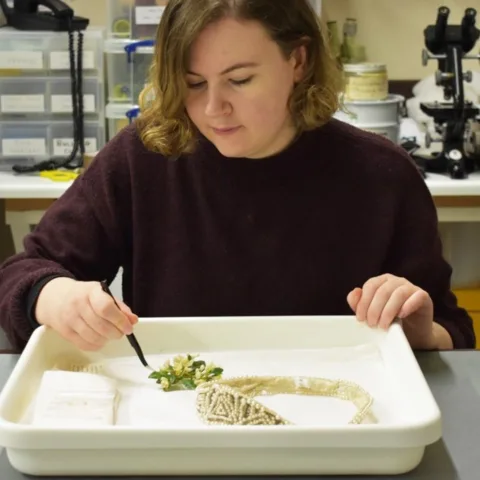The Bowes Museum Blog

Displaying Textiles: Mounting historic dress from the Tullie House Museum & Art Gallery Collection

The Bowes Museum’s ICON (The Institute Of Conservation) textile conservation interns were working on bespoke mounts and supports for items of historic clothing from the Tullie House Museum & Art Gallery, in Carlisle until March. In total, 26 objects from the Tullie House textile collection have been worked on in the Bowes Conservation studio. The collection consists of historic costume and accessories dated from the 18th to the mid 20th century which will be part of a future exhibition at Tullie House.
The costumes will be mounted for display on two different types of mannequins: some made of clear acrylic (supplied from Conservation by Design) and the remainder on stockman mannequins (from Proportion Ltd.). This blogpost will highlight two interesting costumes which have been worked on in the studio and how the different types of mannequins are adjusted for display.
The acrylic mannequins were selected for some of the oldest objects from the collection, including several gowns c. 1750-1800. Acrylic mannequins have the advantage of being transparent, allowing a visitor to see inside the garments in a way that mounts of a different material, such as fiberglass or buckram, would not. This allows construction details to be visible which are normally hidden, such as inside seams, lining fabrics and in some cases makers’ labels.
The Bowes Museum’s Fashion and Textile Gallery was one of the first to make innovative use of acrylic cut-away mannequins when its gallery first opened in 2010. The design for the gallery at the Bowes was led by Claire Gresswell, curator Joanna Hashagen and consultant, conservation and historic dress display specialist Janet Wood. At the beginning of this year Janet Wood visited the Conservation department at the Museum to provide advice for mounting some of the more unusual objects from the Tullie House collection.
Using acrylic mannequins creates an interesting juxtaposition of old and new materials. From a conservation perspective, acrylic (being an inert material) is safe to use alongside fragile fabrics. The biggest challenge has been in adjusting existing shapes and sizes of the mannequins. There are a number of different shapes of acrylic mannequins, some of them specifically designed for historical garments. Some adjustment can be carried out to make the sides of the mannequins smaller or larger but this is normally limited to a few centimetres. If more fullness is required, small silk pads are made for support, for example when creating the mounts of heavily adapted garments. The placement of any additional padding is always made with a view that it should not obscure interesting object details or be easily visible to the viewer. Any that might be seen are made to mimic and blend in with the colouring of the inside of the garment.


Photo © The Bowes Museum and courtesy of Tullie House Museum & Art Gallery. 2020
One particular example that required a fair amount of mannequin adaptation is that of a bodice and skirt made from 18thcentury Spitalfields silk (CALMG: 1972.92.4), which is understood to have once been an 18thcentury gown. Evidence of original folds and pleats can be seen when looking closely. The bodice and skirt had subsequently been reconstructed in the 1840s into a style fashionable at that time. The circumference of the skirt hem is considerably larger than that of other examples which were mounted from the same date. The bodice was larger than other examples in the collection and therefore required support in the form of silk pads, additional arms and petticoats too ensure it fitted the mannequin well. These supports were attached to the acrylic mannequin by threading fishing wire through strategically placed holes in the mannequin using a needle. A final silk layer was then placed between the support and the object to provide a smooth and snag free surface over which the object can easily be positioned on top.




The remainder of the garments from the collection will be displayed on stockman mannequins. Based on the measurements and date of the garments, the mannequins were selected and then additional padding using polyester wadding was attached to create support in specific areas. The date of the object also informs the construction of underpinnings, which both provide support to the object whilst it is on display and create a historically accurate silhouette.
For a bodice and skirt (CALMG: 1984.148.1) dating from 1856-59 a crinoline was constructed. The 3-metre circumference of the crinoline was determined from measuring the hem circumference of the skirt, with 15cm deducted to allow room for a replica silk petticoat between the crinoline and object.
The crinoline was constructed from a 3-metre-long rectangle of calico. Channels were sewn into the calico, into which plastic-covered steel boning was inserted. The bottom channel was the widest and each ring of steel above was set progressively smaller.
It is helpful that original photographs exist from as early as the mid-19th century which can be used as primary source research tools for identifying what shape of crinoline would be needed, although there was some variation and change in fashion between 1856 and 1859, from when the object is dated. There are many examples from this period of similar bodices with wide Pagoda style sleeves and flounced skirts. Notably, the book Victorian and Edwardian Fashion: A Photographic Survey by Alison Gernsheim was a useful source when researching this object.
The images below show how the widths of steel boning affected the shape. In the image to the left the crinoline was too ‘high’. After some adjustment and trimming of the steel a more historically accurate silhouette was achieved.


This skirt presented a particularly unique challenge. Although originally worn as a wedding dress from around 1856, it was later adapted for pregnancy in 1859. The cartridge pleating at the waistband of the skirt had been undone and re-pleated in a way to fit the wider waist of the wearer. The bodice had not been altered and was much smaller in size. In order for the bodice and skirt to be displayed together, a solution was required to give the impression the skirt was its original smaller size.
A method was chosen which connected one side of the original fastening hook and bar on the skirt’s waistband to a corresponding modern hook and bar on a strip of cotton tape. The attachment of this method is shown in figures 9-10. This secures the skirt in a way that overlaps at the side. The support underneath and existing padding prevents a harsh fold line from appearing and the overlap is not visible once the bodice is positioned on top of the skirt.


Photo © Bowes Museum and courtesy of Tullie House Museum & Art Gallery. 2020

These are just two examples which were worked on prior to lockdown. We hope that this blog has provided an interesting glimpse into some of the behind-the-scenes work required when preparing for a textile exhibition. Keep an eye on the Tullie House Museum & Art Gallery website for information regarding this exhibition.
Further Reading: An article discussing the gallery design and use of acrylic mannequins in The Bowes Museum’s Fashion and Textile Gallery can be found in the book Refashioning and Redress: Conserving and Displaying Dress by M. Brookes and D. Eastop 2017.
Blog by: Charlotte Cameron, Textile Conservation Intern at The Bowes Museum
With thanks to: The Institute of Conservation & Tullie House Museum and Art Gallery Trust.







